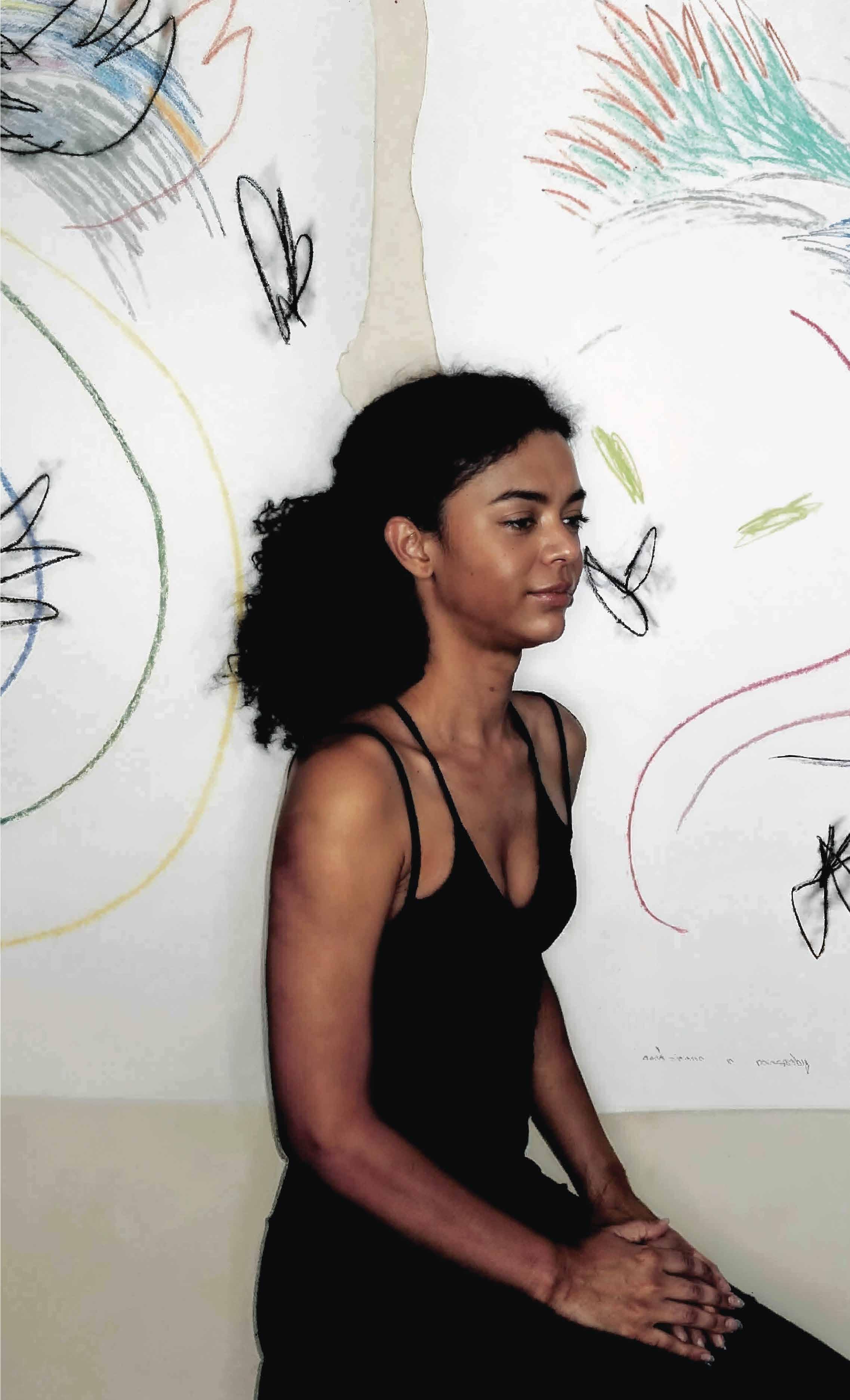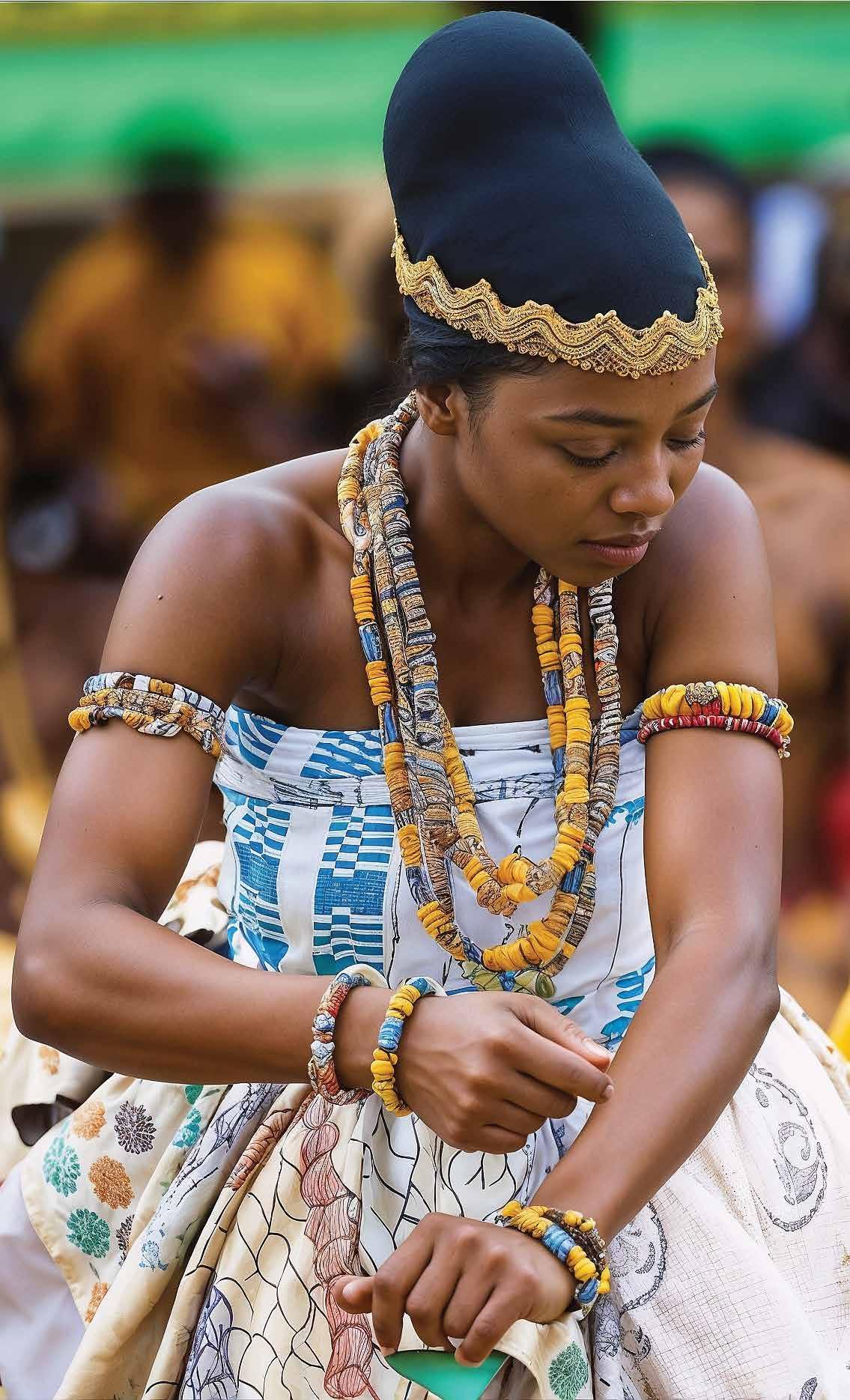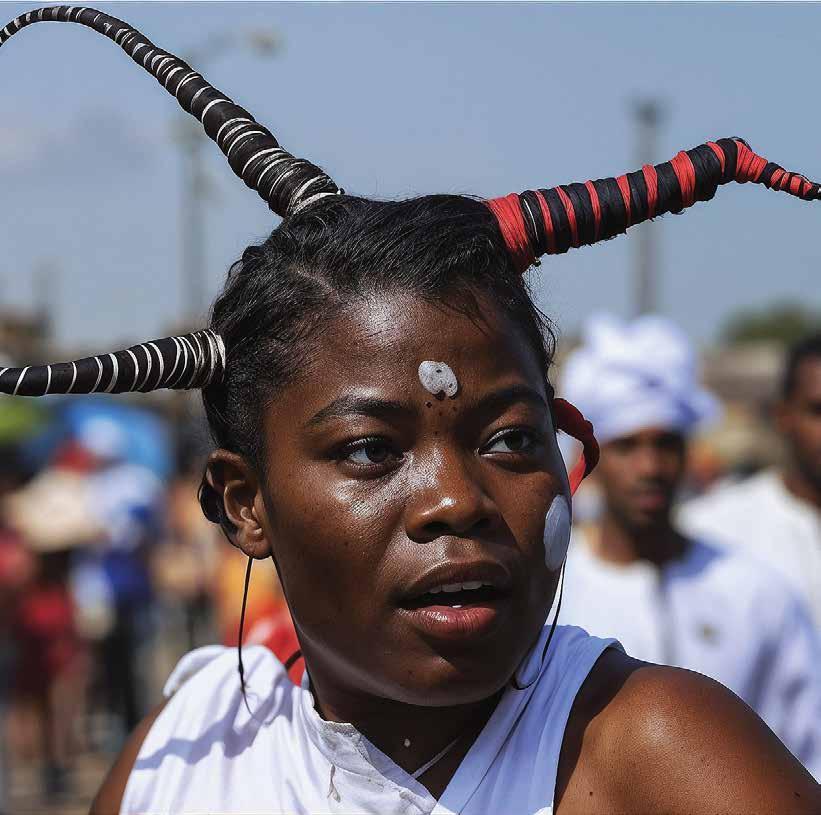






Gbagba-Za








Gbagba-Za
Dear Esteemed Partners and Clients,
At Landtours, we celebrate the power of art to transcend borders and connect us to our shared human experiences. This month, we are thrilled to highlight the incredible work of Tadáskía, an emerging contemporary artist from Rio de Janeiro, Brazil. Her art draws inspiration from the Akan Adinkra symbols found in Ghana.
In this edition, we also share information on upcoming traditional festivals, such as the Homowo festival celebrated by the Ga tribe in the Greater Accra region, the announcement of a new five-star hotel property in Cotonou, Benin, and the upcoming Dak'Art Biennial Festival.
https://landtours.com/
https://landtours.com/
https://landtours.com/

https://landtours.com/ https://landtours.com/
https://landtours.com/
https://www.instagram.com/landtoursgh/ https://www.instagram.com/landtoursgh/ https://www.instagram.com/landtoursgh/ https://www.instagram.com/landtoursgh/ https://www.instagram.com/landtoursgh/ https://www.instagram.com/landtoursgh/ https://www.instagram.com/landtoursgh/ https://www.instagram.com/landtoursgh/ https://www.instagram.com/landtoursgh/ https://www.instagram.com/landtoursgh/ https://www.instagram.com/landtoursgh/ https://www.linkedin.com/company/landtours/ https://www.linkedin.com/company/landtours/ https://www.linkedin.com/company/landtours/ https://www.linkedin.com/company/landtours/ https://www.linkedin.com/company/landtours/ https://www.linkedin.com/company/landtours/ https://www.linkedin.com/company/landtours/ https://www.linkedin.com/company/landtours/ https://www.linkedin.com/company/landtours/ https://www.linkedin.com/company/landtours/ https://www.linkedin.com/company/landtours/ https://www.linkedin.com/company/landtours/ https://www.linkedin.com/company/landtours/
We had the pleasure of hosting a group of almost 100 participants from the National Association of Black Social Workers from the USA. Their itinerary included vibrant welcome and closing dinners with cultural performances that reflected West African heritage, journeys to Cape Coast and Elmina, an NGO visit to Kumasi, a Living Heritage Ceremony where they received new Ghanaian names, and much more.
Take a look at our 10-day trip to Dakar in November, designed around the Dak'Art Biennial Festival. This new package includes notable cultural sites in Senegal such as Gorée Island, Joal-Fadiouth, and Bandia Wildlife Reserve. Create new memories with us as you embark on this exceptional adventure.
As we push further into the remainder of 2024, we look forward to creating new and exciting tour packages focused on ensuring that everyone who travels with us discovers the awe-inspiring landscapes, cultures, and people of West Africa. We are eager to welcome you to where we call home.
Warm regards,

Nov 6th-15th

$3,208 per person double occupancy single supplement: $1,590 from

Nov 6th-15th
City Tour of Dakar Visit key landmarks including Independence Square, Kernel Market, and the IFAN Museum.
Dak'Art Festival Participate in the opening ceremony and explore various exhibitions and art installations.
Gorée Island A UNESCO World Heritage site known for its poignant history as a former slave trading post.
Joal Fadiouth Explore this unique village known for its shell-covered island and mixed-faith cemetery.
Bandia Wildlife Reserve Encounter diverse wildlife in their natural habitat.
Saloum Delta Enjoy a scenic boat ride through the lush mangroves and serene waters of the delta.
Artistic Immersion Engage with renowned artists and explore diverse contemporary artworks at the Dak'Art Festival.
Historical Insights Gain a deep understanding of Senegal's history through visits to Gorée Island and other historical sites.
Cultural Experiences Interact with local communities and learn about their customs and traditions in Joal Fadiouth and other villages.
Natural Beauty Experience Senegal’s wildlife and natural landscapes in Bandia Reserve and the Saloum Delta.
• Private air-conditioned vehicle
• Best 3/5-star hotels in Dakar and Saly
• Daily breakfast, plus additional meals as specified
• Entry fees to sites included as per the itinerary
• Professional tour guide and licensed driver


8
11
august 2024 | issue #7

8
tadáskía - bridging cultures through contemporary Art
Tadáskía, born in 1993 in Rio de Janeiro, Brazil, is an emerging force in contemporary art. Her work spans various mediums, including drawing, sculpture, and installation, and reflects her multifaceted identity as an afro-latina.


12
12 14 14 15

Tadáskía, born in 1993 in Rio de Janeiro, Brazil, is an emerging force in contemporary art. Her work spans various mediums, including drawing, sculpture, and installation, and reflects her multifaceted identity as an Afro-Latina. Tadáskía’s art is deeply rooted in her lived experiences and cultural background, weaving together themes of transformation, spirituality, and the passage of time.
One of the hallmarks of Tadáskía’s work is her exploration of mudança - a Portuguese word meaning change. This concept is central to her practice, as seen in her unbound book "ave preta mística mystical black bird" (2022), which features freeform drawings accompanied by poetic, bilingual text. This work, a highlight of her recent exhibition at MoMA, narrates a journey of freedom through the eyes of a winged protagonist, mirroring Tadáskía’s own journey of self-discovery and liberation.
In her youth, Tadaskia encountered Sankofa - an Akan Adinkra symbol native to Ghana in West Africa depict-

ed by a winged bird with its head turned backwards, during a conference prior to college. This partly influenced her artistic expressions coupled with her African heritage through her mother who was significant in her growth and journey as an artist. The Sankofa Adinkra symbol gleans on the ideology of returning to one’s roots as a guiding light to the path for the future. The Sankofa symbol also alludes to humility, reminding us that no matter the successes one achieves, a sense of humility and reverence of the past should always be maintained.
Tadáskía's art often employs organic materials and reflects a deep connection to nature and transformation. For instance, in her large-scale installation at the 35th São Paulo Biennial, she used materials like char-


coal and dry pastel to create immersive wall drawings and sculptures. This installation was noted for its vibrant colors and dynamic forms, sparking a sense of movement and life.
A significant aspect of Tadáskía’s work is its spiritual dimension, which conflates different religions and merges them into one fluid thought. Raised in a Pentecostal household, she later incorporated elements from Afro-Brazilian religions such as Candomblé and Umbanda into her art. This fusion is evident in her use of ritualistic materials like olive oil, cattails, and beads, which carry symbolic meanings in these traditions.
Tadáskía’s artistic process is deeply introspective and physical. She often begins her drawings with her eyes closed in prayer, allowing her hand to be guided by


intuition and memory. This method results in compositions that are both spontaneous and deliberate, capturing the fluidity and imperfection inherent in the act of creation. In her own words, Tadáskía embraces the "errors" in her work, viewing them as integral to the drawing’s intelligence and evolution.
Her recent solo exhibitions, such as "Flores e frutas" at Galpão Bela Maré in Rio de Janeiro and "As Parecidas" at Galeria Madragoa in Lisbon, have further established her as a significant voice in contemporary art. These shows highlight her ability to create immersive environments that engage viewers on multiple sensory and emotional levels.
Tadáskía’s work is not only a personal expression but also a commentary on broader social and cultural


Above: A Tadáskía print from the Harlem studio opening
issues. Her art challenges conventional notions of identity, beauty, and belonging, offering a nuanced perspective on the complexities of the human experience. By drawing on her own experiences and cultural heritage, Tadáskía creates works that resonate with a diverse audience, encouraging reflection and dialogue.
Through Tadáskía’s art, there is a deep sense of appreciation and merging of cultures across continents which continues to gain recognition. Her work shines a light on the transformative potential of art through her unique vision and innovative approach to materials and themes that make her a standout figure in the contemporary art world.

The Dak'Art Festival, also known as the Biennale of Contemporary African Art, is a prestigious event held in Dakar, Senegal, that showcases the vibrant and dynamic art scene of Africa. Since its inception in 1992, the festival has grown to become one of the most significant platforms for African artists to exhibit their work to a global audience.
The 2024 edition is scheduled to run from November 2nd to December 2nd after being postponed. Each edition of Dak'Art is centered around a unique theme that reflects contemporary issues and artistic explorations within the African context with 2024’s theme titled “The Wake: L’éveil, Xàll wi. This year’s edition will see a convergence of over 50 artists from Africa and the diaspora such as Sonia Barrett from Jamaica, Ama Be - a Ghanaian American, Sika de Silveira from Benin, Mohamed Diop from Senegal amongst an impressive lineup.
The origin of Dak'Art dates back to 1989 when it was first conceived as a way to promote African contemporary art. However, it was officially established in 1992 by the Senegalese government as part of its commitment to cultural development and the arts.
Visitors to Dak'Art can expect not only a visual feast of paintings, sculptures, installations, and multimedia works but also a vibrant atmosphere filled with workshops, panel discussions, and cultural performances. These events provide invaluable opportunities for artists to engage in meaningful dialogue with peers and audiences, building a sense of community and collaboration.
The festival is hosted at various venues throughout Dakar, including the Village de la Biennale, which serves as the central hub for exhibitions and events. Additionally, off-site exhibitions and events spread across the city allow visitors to explore different neighborhoods and experience the local culture alongside contemporary art.
Over the years, Dak'Art has played a crucial role in elevating the profiles of African artists on the global stage. It has also contributed to the growth of the local art market, attracting collectors, curators, and art enthusiasts from around the world. The festival's impact is not limited to the art world; it also stimulates the local economy, boosts tourism, and enhances Dakar's reputation as a cultural hub.


The Homowo festival, which translates to “hooting at hunger” and celebrated by the Ga-Adangbe tribe indigenous to the Greater Accra region is slated to be held across the different Ga locales in the region in August.
The origins of the Homowo Festival are rooted in the migration history of the Ga people. According to local lore, the Ga people migrated from the Ile-Ife in Nigeria, traveling through Benin and Togo before finally settling along the coastal plains of present-day Accra. During their arduous journey, they faced numerous challenges, including famine and food scarcity.
Through collective effort and perseverance, they managed to cultivate their first successful harvest and in gratitude and celebration of their survival and

newfound food security, they instituted Homowo, a festival to mock hunger and celebrate abundance.
Homowo is celebrated with great pomp and pageantry, typically beginning in May and culminating in August, after the planting season. The festival’s activities are spread across several weeks and involve various rituals and customs that underscore its significance.
One of the key pre-festival activities is the planting of maize, a staple crop for the Ga people. This act represents hope and future prosperity amongst the Ga people. Leading up to the main event, there is a ban on drumming and noise-making to allow for a period of peace and reflection.
The climax of Homowo occurs in August, marked by the sprinkling of 'kpokpoi' or 'kpashimo,' a traditional Ga dish made from maize and palm oil, on the streets and in homes. This act is both a symbolic gesture to remember the difficult times of famine and a way to offer thanks for the current abundance. Chiefs and elders of the various Ga communities, adorned in vibrant traditional attire, lead the procession, performing libations and prayers to honor the ancestors and the gods.
Dancing, drumming, and singing fill the air as the community comes together in joyous celebration. The Homowo Festival also features a vibrant display of Ga culture through traditional music, dance performances, and storytelling sessions that recount the tribe's history and folklore. The festival also fosters a sense of continuity and tradition, as the younger generation participates in and learns about the customs and practices of their ancestors. This transmission of cultural knowledge ensures that the rich heritage of the Ga people is preserved and passed down through the ages.
Homowo is a powerful expression of cultural pride and communal solidarity. It encapsulates the essence of the Ga people’s identity, celebrating their past struggles, present achievements, and future aspirations. As the drums beat and the people dance, Homowo continues to be a reflection of the enduring spirit and cultural richness of the Ga-Adangbe people of Ghana.

After a long-awaited launch, the Sofitel Cotonou Marina Hotel and Spa is set to be unveiled on the 1st of September, 2024 as the Accor group’s newest 5-star property. Located in the capital of Benin, the hotel boasts 198 rooms and features two swimming pools, three concept restaurants, two tennis courts, and a 1,000-square-meter spa. Strategically situated just 15 minutes away from the Cotonou International Airport and close to key sites in the city such as Danktopa Market, the hotel will contribute significantly to expanding the tourism and hospitality infrastructure in West Africa.
The hotel was designed by the multi-award-winning Sundukovy Sisters, who have created first-class restaurants and hotels across the Middle East, USA, and Asia, working with leaders in the hospitality industry such as Marriott, Hilton, Radisson, and Pullman, among others. The sisters affirm that their designs go through several stages of the creative process, drawing inspiration from the history of each location while balancing relevance, functionality, and aesthetics.
The Sofitel Marina Hotel is poised to boost the local economy through job creation and the development of ancillary businesses. The hotel's need for a skilled workforce will provide employment opportunities for residents, ranging from hospitality management to culinary arts and customer service. Furthermore, local suppliers and service providers stand to benefit from the increased demand for goods and services, fostering economic growth and sustainability in the region.
In addition to economic benefits, the Sofitel Marina Hotel will enhance Benin's global profile as a burgeoning cultural tourist destination. By offering world-class accommodations and services, the hotel will help position Benin as a competitive option for international travelers seeking unique experiences in West Africa. This increased visibility can encourage further investment in the country's tourism infrastructure, such as improvements in transportation, communication networks, and tourist attractions.
The Sofitel Marina Hotel also aligns with Benin's broader tourism strategy, which aims to showcase the country's cultural heritage, historical landmarks, and natural beauty. By providing global standards for tourists to explore these attractions, the hotel is poised to contribute to the promotion and preservation of Benin's unique cultural identity.
Below: Inside the Sofitel Hotel


Landtours recently had the privilege of hosting the National Association of Black Social Workers (NABSW) from the United States, marking a transformative journey for many participants who were visiting Ghana for the first time.
A vibrant welcome dinner at Makosa Restaurant featured a captivating cultural performance, setting the tone for an immersive cultural adventure. The tour was also filled with enriching experiences, starting with a heartfelt naming ceremony in Torgorme that connected guests with their heritage.
The itinerary included an insightful tour of Cape Coast Castle, a canopy walk at Kakum National Park, and a poignant visit to Assin Manso Slave River, allowing participants to reflect on their roots. The group also explored Kumasi, with a city tour, and made meaningful contributions during charity visits to the KNUST Kumasi Children's Home and Edwenase Rehabilitation Centre.
This trip was a profound and eye-opening experience, particularly for those discovering the beauty and history of Ghana for the first time, building a deep connection to their ancestry.


$2,985 per person double occupancy single supplement: $850 from
July 28th - August 9th
Embark on an enriching 13-day journey through Ghana, Togo, and Benin, delving into the rich cultural heritage, historical landmarks, and vibrant traditions of West Africa. This tour, centered around the Panafest celebrations, offers an immersive experience with a focus on the region's poignant history and colorful traditions. Participants will explore bustling cities, ancient castles, traditional villages, and vibrant markets, while also engaging in a unique private Voodoo ceremony in Benin.
Accra City Tour Discover Ghana's capital with visits to the W.E.B. Du Bois Center, Independence Square, and the Kwame Nkrumah Memorial Park.
Slave Dungeon Experience Visit the infamous Elmina and Cape Coast Castles, poignant reminders of the trans-Atlantic slave trade.
Panafest Celebration Participate in the moving Reverential Night, candlelight processions, and the Emancipation Day Durbar at Assin Manso.
Kumasi City Tour Explore the Ashanti Kingdom with visits to the Manhyia Palace Museum, Kejetia Market, and Ashanti craft villages.
Living Heritage Ceremony Engage in a traditional naming ceremony at Torgorme Village.
Lome City Tour Enjoy an insightful tour through the capital city of Togo. Be enthralled by the different sights that have shaped and contributed to part of the cultural heritage of the country.
Voodoo Festival Experience a private Voodoo festival in Benin, witnessing traditional rituals and dances.
• Accommodation in 3 to 5-star hotels
• Daily breakfast, 2 lunches, and 7 dinners
• All entry fees as per itinerary
• Professional tour guide and licensed chauffeur
• Air-conditioned transportation

$2,985 per person double occupancy single supplement: $850 from
For more information and bookings, contact us at: Email: travelafrica@landtours.com
